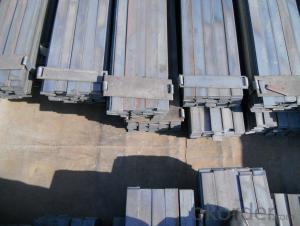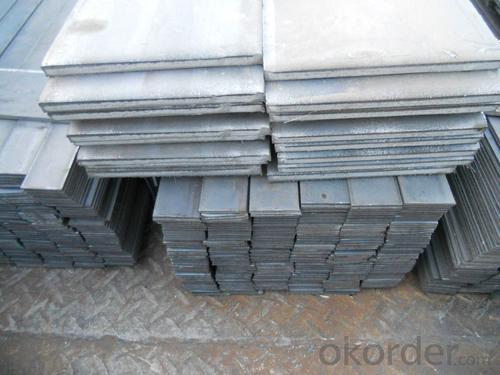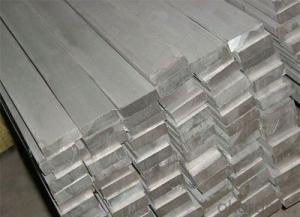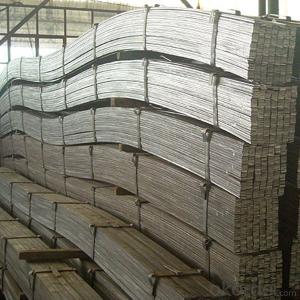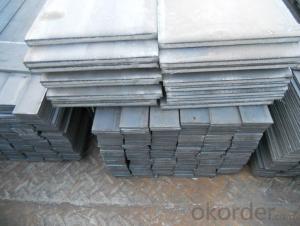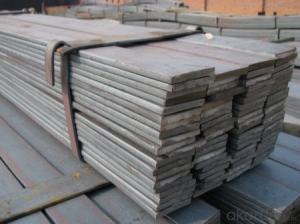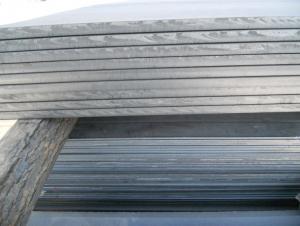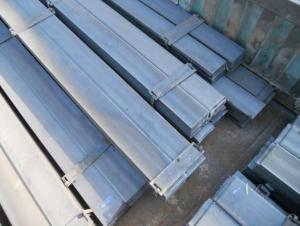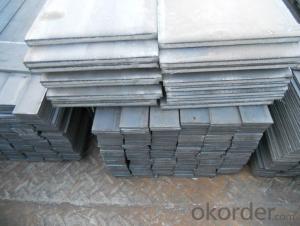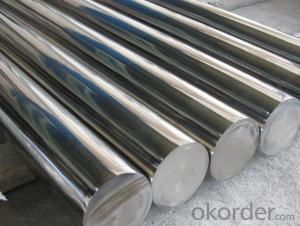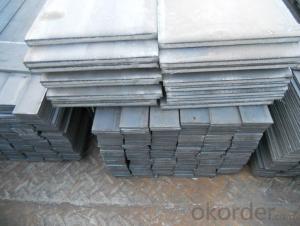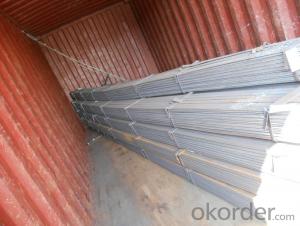manufacture direct supply steel flat; flat steel bars
- Loading Port:
- Tianjin
- Payment Terms:
- TT or LC
- Min Order Qty:
- 1000 m.t.
- Supply Capability:
- 10000 m.t./month
OKorder Service Pledge
OKorder Financial Service
You Might Also Like
Commodity: Q235 Steel Flat Bar
Standard: GB
Material: Q235
Brand name: FLATSPACE
Origin place: China
Thickness: 3mm-30mm
Width:20mm-200mm
Length: Max 12m
Certification: SGS/BV
Chemical composition of Q235
Alloy No | Grade | Element(%) | ||||
C
| Mn
| S
| P
| Si
| ||
Q235
|
B
|
0.12—0.20 |
0.3—0.7 |
≤0.045 |
≤0.045
|
≤0.3
|
Physical properties of Q235
Alloy No | Grade | Yielding strength point(Mpa) | Tensile strength (Mpa) | Elongation after fracture(%) | ||||||
Thickness (mm) | Thickness (mm) | |||||||||
≤16 | >16--40 | >40--60 | >60--100 | ≤16 | >16--40 | >40--60 | >60--100 | |||
≥ | ≥ | |||||||||
Q235 |
B |
235 |
225 |
215 |
205 |
375--500 |
26 |
25 |
24 |
23 |
Usage/Applications of Q235 Steel Flat Bar
Widely used for construction, Machinery manufacturing, Iron tower steel structure, Shipbuilding; Steel grating, Staircase, Bridge, Viaduct, Railway spare parts, Boilers making etc.
Production Flow of Q235 Steel Flat Bar
The steel flat bar is made through three processes:
1.Feeding the material: Feeding the row material (the steel plate) to Slitting Line.
2.Slitting:The steel plate would be slitted into expected width by lengthways cutter.
3. Leveled and cutting: The plat bar would be ground into level by the grinder and then cut into required length.
Packaging & Delivery of Q235 Steel Flat Bar
Packaging Details: The Steel Flat Bars are packed in bundles and loaded in 20 feet/40 feet container, or shipped by bulk cargo ,also we can do as customer's requirements.
Delivery Details:30~45 days upon the receipt of buyer payment by T.T. or L/C.
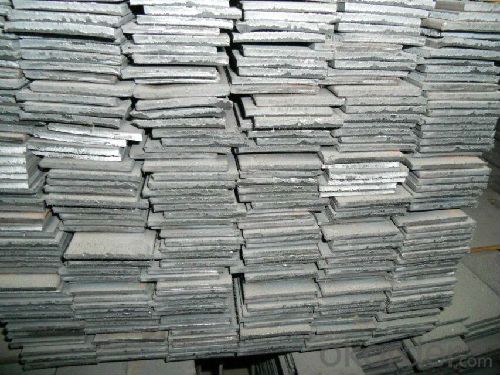

- Q: What are the applications of steel flat bars in construction?
- Due to their versatility and durability, steel flat bars find wide application in the construction industry. These bars serve multiple purposes in various construction projects, including providing structural support, reinforcement, and framing. One of the primary uses of steel flat bars in construction involves their role as supports or beams. They offer additional strength and stability to structures like bridges, buildings, and platforms. Steel flat bars also serve as lintels above windows and doors, providing structural support and preventing sagging or cracking. Another common application of steel flat bars is their use in reinforcing concrete structures. These bars are embedded within concrete to enhance tensile strength and prevent cracking under heavy loads or vibrations. They are commonly employed in the construction of foundations, columns, slabs, and walls. Steel flat bars are also utilized for framing purposes in construction projects. They can function as framing members for walls, ceilings, and roofs, creating a robust and rigid framework. Furthermore, they can act as braces to reinforce structures against lateral forces, such as wind or earthquakes. In addition to their structural applications, steel flat bars are employed for decorative purposes in construction. They can serve as architectural accents, handrails, or ornamental fixtures, enhancing the aesthetic appeal of buildings and structures. Overall, the applications of steel flat bars in construction are extensive. Their strength, durability, and versatility make them an indispensable component in various construction projects, ensuring the stability, safety, and longevity of structures.
- Q: Are there any safety considerations when working with steel flat bars?
- Yes, there are several safety considerations when working with steel flat bars. Firstly, steel flat bars can be heavy and cumbersome, so it is important to use proper lifting techniques and equipment to avoid strain or injury. Additionally, steel bars may have sharp edges or corners that can cause cuts or punctures, so wearing appropriate personal protective equipment such as gloves and safety glasses is essential. Furthermore, when cutting or shaping steel flat bars, sparks and metal fragments can be generated, posing a fire hazard and eye injury risk. It is crucial to work in a well-ventilated area and use proper eye protection and fire prevention measures. Lastly, steel flat bars can become extremely hot when welding or using other high-temperature processes, leading to burn injuries. Adhering to proper welding techniques and wearing heat-resistant clothing and gloves can minimize these risks. Overall, being aware of these safety considerations and following best practices is crucial to ensuring the safe handling and manipulation of steel flat bars.
- Q: Can steel flat bars be used for making blades or cutting edges?
- Yes, steel flat bars can be used for making blades or cutting edges, as they offer strength, durability, and a sharp edge that is ideal for cutting through various materials. However, the specific type of steel and its hardness will determine the effectiveness and suitability for different cutting applications.
- Q: What are the cost implications of using steel flat bars compared to other materials?
- The cost implications of using steel flat bars compared to other materials can vary depending on several factors. Generally, steel flat bars tend to be more cost-effective compared to materials like aluminum or titanium. Steel is a widely available and relatively inexpensive material, making it a popular choice for various applications. Additionally, steel flat bars offer high strength and durability, reducing the need for frequent replacements or repairs. However, it's important to consider the specific project requirements, as certain applications may require the use of more expensive materials for specialized properties or aesthetics.
- Q: Can steel flat bars be used for making storage racks or shelving systems?
- Certainly, storage racks or shelving systems can be created using steel flat bars. Renowned for their robustness and long-lasting nature, steel flat bars are an excellent option for bolstering weighty loads on storage racks or shelving systems. They offer stability and endurance, enabling them to withstand the heaviness of diverse items, rendering them appropriate for arranging and storing merchandise in warehouses, garages, or even residences. Furthermore, steel flat bars can be easily joined together through welding or bolting, facilitating the creation of tailor-made storage solutions that fulfill specific requirements. On the whole, steel flat bars serve as a dependable and adaptable choice for constructing storage racks or shelving systems.
- Q: How do you protect steel flat bars from chemical corrosion?
- One effective way to protect steel flat bars from chemical corrosion is by applying a protective coating or paint. The coating creates a barrier between the steel and the corrosive chemicals, preventing direct contact and minimizing the risk of corrosion. Additionally, regularly inspecting and maintaining the coating for any damage or wear is crucial to ensure long-term protection.
- Q: How do steel flat bars perform in terms of chemical resistance?
- The chemical resistance of steel flat bars is generally good, but it can vary depending on the grade and composition of the steel. Stainless steel flat bars, for instance, have exceptional resistance to a wide range of chemicals, including acids, alkalis, and organic solvents. This is because stainless steel contains a high amount of chromium, which creates a protective oxide layer on the surface known as passive film. This film prevents corrosion and chemical attack. On the contrary, carbon steel flat bars are more prone to corrosion but still display satisfactory chemical resistance in many environments. They can withstand most organic chemicals but may be affected by strong acids, alkalis, and specific corrosive substances. To enhance the chemical resistance of carbon steel in such cases, protective coatings or surface treatments can be applied. In general, steel flat bars are widely used across various industries due to their favorable chemical resistance. However, it is crucial to consider the specific grade and composition of the steel, as well as the intended application and the specific chemicals it will be exposed to, in order to determine the necessary level of chemical resistance.
- Q: How do I calculate the weight of a steel flat bar?
- To calculate the weight of a steel flat bar, you need to know its dimensions and the density of steel. The weight of an object can be determined by multiplying its volume by its density. 1. Measure the length, width, and thickness of the steel flat bar in inches or any other unit of measurement. 2. Convert the measurements to the same unit, if necessary, for consistency. 3. Calculate the volume of the flat bar by multiplying the length, width, and thickness of the steel flat bar. The formula is Volume = Length x Width x Thickness. 4. Look up the density of steel in pounds per cubic inch or any other unit of measurement. The density of steel is approximately 0.2836 pounds per cubic inch. 5. Multiply the volume of the flat bar by the density of steel to obtain the weight. The formula is Weight = Volume x Density. By following these steps, you can accurately calculate the weight of a steel flat bar based on its dimensions and the density of steel.
- Q: Are steel flat bars commonly used in the construction of industrial buildings?
- Yes, steel flat bars are commonly used in the construction of industrial buildings. Steel is a versatile and durable material that is widely used in construction due to its strength and ability to withstand heavy loads. Flat bars, in particular, are popular in industrial buildings because they offer a stable and even surface for structural support, as well as for framing and reinforcing purposes. They are often used as beams, columns, and braces, providing essential structural integrity to the building. Additionally, steel flat bars are easy to work with and can be customized to meet specific design requirements, making them a preferred choice in industrial construction projects.
- Q: Are steel flat bars suitable for machining or drilling?
- Steel flat bars are indeed suitable for machining and drilling. Steel is a strong and durable material that can be easily shaped, cut, and drilled into various forms. Flat bars, in particular, provide a stable and rigid surface for machining operations, allowing for precise and accurate cuts. With the right tools and techniques, steel flat bars can be easily drilled to create holes of different sizes and shapes. Whether it is for creating prototypes, constructing machinery, or any other application that requires precise shaping and drilling, steel flat bars are a reliable choice.
Send your message to us
manufacture direct supply steel flat; flat steel bars
- Loading Port:
- Tianjin
- Payment Terms:
- TT or LC
- Min Order Qty:
- 1000 m.t.
- Supply Capability:
- 10000 m.t./month
OKorder Service Pledge
OKorder Financial Service
Similar products
Hot products
Hot Searches
Related keywords


